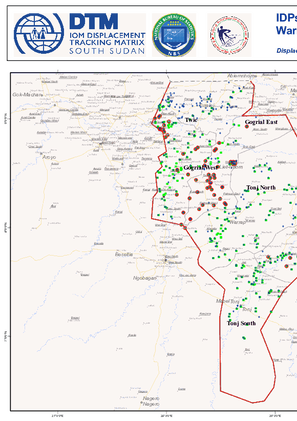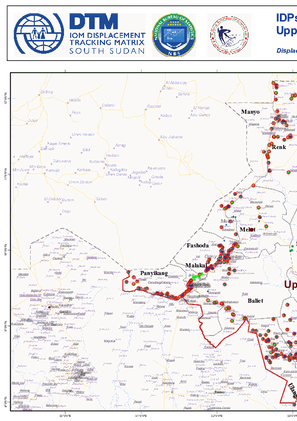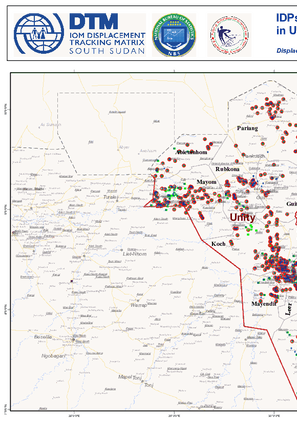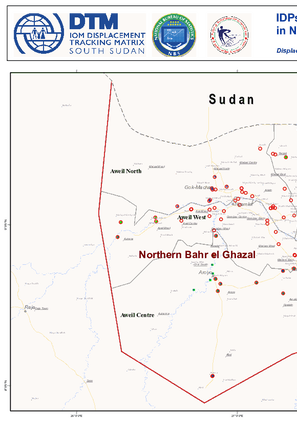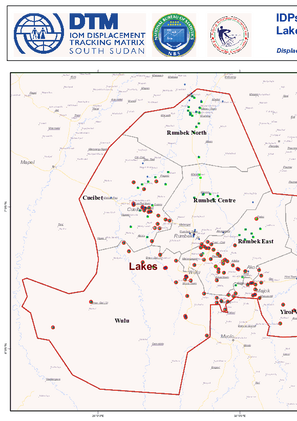-
Countries
-
Data and Analysis
-
Special Focus
-
Crisis Responses

Contact
DTMMozambique@iom.int
Language
English
Location
Mozambique
Period Covered
Jun 02 2022
Jun 14 2022
Activity
- Mobility Tracking
- Event Tracking
Fear of attacks and subsequent confirmed attacks in Ancuabe district by Non-State Armed Groups triggered the movements of 15,479 individuals within Ancuabe, Chiure, Quissanga, Balama, Mecufi, Mueda, Macomia, Montepuez, Meluco, Namuno, Nampula, Balama, Metuge and Cidade de Pemba. Approximately 511 IDPs have been identified with vulnerabilities. At least 42% of these movements are arrivals in Cidade de Pemba. New arrivals recorded within this report map 6,266 individuals predominantly moving into sites across Chiure, Metuge and Ancuabe.
The objective of the Emergency Tracking Tool (ETT) - Movement Alert is to collect information on large and sudden population movements, and to provide support to humanitarian response partners by disseminating data on IDPs for ensuring effective humanitarian response to the affected population. Information is collected through key informant interviews or direct observation. The dashboard provides basic information on displacements, and additional information can be shared upon request. IOM identified 11,737 individual displacement movements in the previous reporting period (02-13 June). Impact of new attacks reported between 9 and 13 June in Ancuabe and Chiure districts account for the increase of displacement movements representing 15,479 individuals. Current figures are to be considered as cumulative displacement movements observed between 02-14 June.

Contact
DTM Niger, NigerDataResearch@iom.int
Language
French
Location
Niger
Period Covered
Apr 11 2022
May 03 2022
Activity
- Mobility Tracking
- Site Assessment
- Baseline Assessment
- Village Assessment
Depuis 2018, les régions de Diffa, Maradi, Tahoua et Tillabéri du Niger sont témoin de mouvements importants de personnes déplacées en lien avec les multiples crises sécuritaires touchant les pays. l’Organisation Internationale pour les Migrations (OIM) au Niger, à travers sa Matrice de Suivi des Déplacements (Displacement Tracking Matrix DTM) a conduit des évaluations, avec la participation des autorités (Ministère de l’Action Humanitaire et de la Gestion des Catastrophes, et Direction Régionale de l’Etat Civil des Migrations et des Refugiés) dans tous les villages des régions affectées hébergeant des populations déplacées pour collecter des informations sur l’ampleur, l’évolution, les tendances des déplacements internes, l'accès aux services de base et les besoins humanitaires des populations affectées, permettant ainsi au gouvernement du Niger et aux partenaires humanitaires de mener une réponse mieux ciblée et adaptée. Les évaluations DTM sont menées à travers des questionnaires à destination d’informateurs clés ayant une connaissance approfondie de la situation des Personnes déplacées. Le présent tableau de bord offre un résumé succinct des résultats clés de la quatrième ronde d’évaluations DTM menée du 11 Avril au 03 Mai 2022.
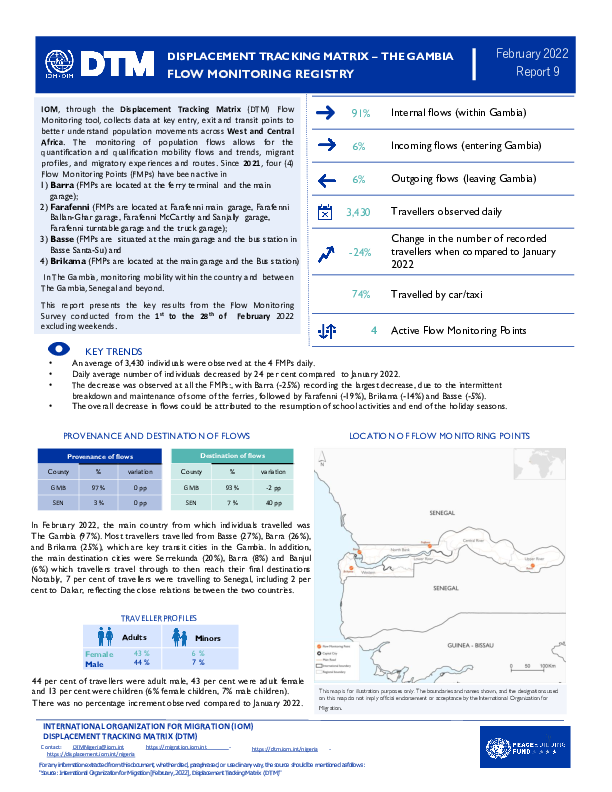
Contact
RO Dakar, RODakar-DataResearch@iom.int
Language
English
Location
The Gambia
Period Covered
Feb 01 2022
Feb 28 2022
Activity
- Flow Monitoring
IOM, through the Displacement Tracking Matrix (DTM) Flow Monitoring tool, collects data at key entry, exit and transit points to better understand population movements across West and Central Africa. The monitoring of population flows allows for the quantification and qualification mobility flows and trends, migrant profiles, and migratory experiences and routes. Since 2021, four (4) Flow Monitoring Points (FMPs) have been active in
1) Barra (FMPs are located at the ferry terminal and the main
garage);
2) Farafenni (FMPs are located at Farafenni main garage, Farafenni
Ballan-Ghar garage, Farafenni McCarthy and Sanjally garage,
Farafenni turntable garage and the truck garage);
3) Basse (FMPs are situated at the main garage and the bus station in
Basse Santa-Su) and
4) Brikama (FMPs are located at the main garage and the Bus station)
In The Gambia, monitoring mobility within the country and between The Gambia, Senegal and beyond.
This report presents the key results from the Flow Monitoring Survey conducted from the 1st to the 28th of February 2022 excluding weekends.


